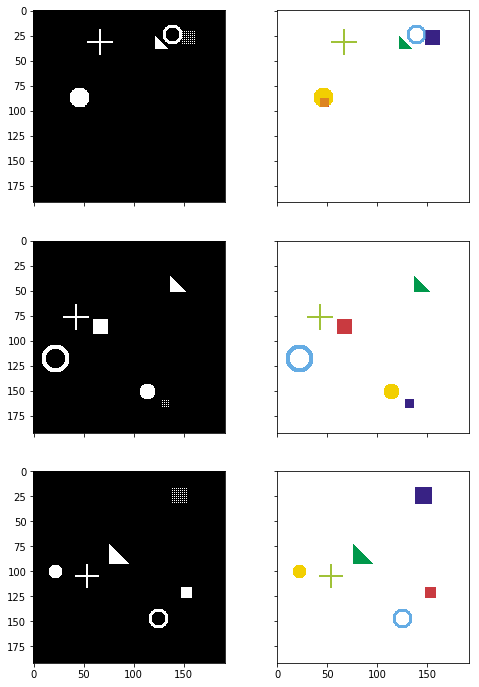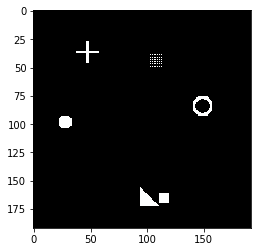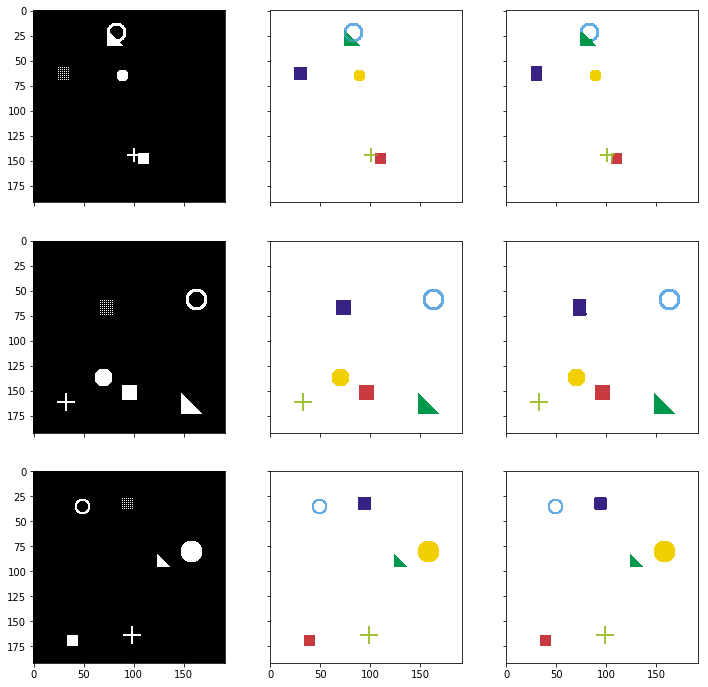This repository contains simple PyTorch implementations of U-Net and FCN, which are deep learning segmentation methods proposed by Ronneberger et al. and Long et al.
- U-Net: Convolutional Networks for Biomedical Image Segmentation
- Fully Convolutional Networks for Semantic Segmentation
First clone the repository and cd into the project directory.
import matplotlib.pyplot as plt import numpy as np import helper import simulation # Generate some random images input_images, target_masks = simulation.generate_random_data(192, 192, count=3) for x in [input_images, target_masks]: print(x.shape) print(x.min(), x.max()) # Change channel-order and make 3 channels for matplot input_images_rgb = [x.astype(np.uint8) for x in input_images] # Map each channel (i.e. class) to each color target_masks_rgb = [helper.masks_to_colorimg(x) for x in target_masks] # Left: Input image (black and white), Right: Target mask (6ch) helper.plot_side_by_side([input_images_rgb, target_masks_rgb])from torch.utils.data import Dataset, DataLoader from torchvision import transforms, datasets, models class SimDataset(Dataset): def __init__(self, count, transform=None): self.input_images, self.target_masks = simulation.generate_random_data(192, 192, count=count) self.transform = transform def __len__(self): return len(self.input_images) def __getitem__(self, idx): image = self.input_images[idx] mask = self.target_masks[idx] if self.transform: image = self.transform(image) return [image, mask] # use the same transformations for train/val in this example trans = transforms.Compose([ transforms.ToTensor(), transforms.Normalize([0.485, 0.456, 0.406], [0.229, 0.224, 0.225]) # imagenet ]) train_set = SimDataset(2000, transform = trans) val_set = SimDataset(200, transform = trans) image_datasets = { 'train': train_set, 'val': val_set } batch_size = 25 dataloaders = { 'train': DataLoader(train_set, batch_size=batch_size, shuffle=True, num_workers=0), 'val': DataLoader(val_set, batch_size=batch_size, shuffle=True, num_workers=0) }import torchvision.utils def reverse_transform(inp): inp = inp.numpy().transpose((1, 2, 0)) mean = np.array([0.485, 0.456, 0.406]) std = np.array([0.229, 0.224, 0.225]) inp = std * inp + mean inp = np.clip(inp, 0, 1) inp = (inp * 255).astype(np.uint8) return inp # Get a batch of training data inputs, masks = next(iter(dataloaders['train'])) print(inputs.shape, masks.shape) plt.imshow(reverse_transform(inputs[3]))torch.Size([25, 3, 192, 192]) torch.Size([25, 6, 192, 192]) import torch import torch.nn as nn from torchvision import models def convrelu(in_channels, out_channels, kernel, padding): return nn.Sequential( nn.Conv2d(in_channels, out_channels, kernel, padding=padding), nn.ReLU(inplace=True), ) class ResNetUNet(nn.Module): def __init__(self, n_class): super().__init__() self.base_model = models.resnet18(pretrained=True) self.base_layers = list(self.base_model.children()) self.layer0 = nn.Sequential(*self.base_layers[:3]) # size=(N, 64, x.H/2, x.W/2) self.layer0_1x1 = convrelu(64, 64, 1, 0) self.layer1 = nn.Sequential(*self.base_layers[3:5]) # size=(N, 64, x.H/4, x.W/4) self.layer1_1x1 = convrelu(64, 64, 1, 0) self.layer2 = self.base_layers[5] # size=(N, 128, x.H/8, x.W/8) self.layer2_1x1 = convrelu(128, 128, 1, 0) self.layer3 = self.base_layers[6] # size=(N, 256, x.H/16, x.W/16) self.layer3_1x1 = convrelu(256, 256, 1, 0) self.layer4 = self.base_layers[7] # size=(N, 512, x.H/32, x.W/32) self.layer4_1x1 = convrelu(512, 512, 1, 0) self.upsample = nn.Upsample(scale_factor=2, mode='bilinear', align_corners=True) self.conv_up3 = convrelu(256 + 512, 512, 3, 1) self.conv_up2 = convrelu(128 + 512, 256, 3, 1) self.conv_up1 = convrelu(64 + 256, 256, 3, 1) self.conv_up0 = convrelu(64 + 256, 128, 3, 1) self.conv_original_size0 = convrelu(3, 64, 3, 1) self.conv_original_size1 = convrelu(64, 64, 3, 1) self.conv_original_size2 = convrelu(64 + 128, 64, 3, 1) self.conv_last = nn.Conv2d(64, n_class, 1) def forward(self, input): x_original = self.conv_original_size0(input) x_original = self.conv_original_size1(x_original) layer0 = self.layer0(input) layer1 = self.layer1(layer0) layer2 = self.layer2(layer1) layer3 = self.layer3(layer2) layer4 = self.layer4(layer3) layer4 = self.layer4_1x1(layer4) x = self.upsample(layer4) layer3 = self.layer3_1x1(layer3) x = torch.cat([x, layer3], dim=1) x = self.conv_up3(x) x = self.upsample(x) layer2 = self.layer2_1x1(layer2) x = torch.cat([x, layer2], dim=1) x = self.conv_up2(x) x = self.upsample(x) layer1 = self.layer1_1x1(layer1) x = torch.cat([x, layer1], dim=1) x = self.conv_up1(x) x = self.upsample(x) layer0 = self.layer0_1x1(layer0) x = torch.cat([x, layer0], dim=1) x = self.conv_up0(x) x = self.upsample(x) x = torch.cat([x, x_original], dim=1) x = self.conv_original_size2(x) out = self.conv_last(x) return outdevice = torch.device('cuda' if torch.cuda.is_available() else 'cpu') model = ResNetUNet(n_class=6) model = model.to(device) # check keras-like model summary using torchsummary from torchsummary import summary summary(model, input_size=(3, 224, 224))---------------------------------------------------------------- Layer (type) Output Shape Param # ================================================================ Conv2d-1 [-1, 64, 224, 224] 1,792 ReLU-2 [-1, 64, 224, 224] 0 Conv2d-3 [-1, 64, 224, 224] 36,928 ReLU-4 [-1, 64, 224, 224] 0 Conv2d-5 [-1, 64, 112, 112] 9,408 BatchNorm2d-6 [-1, 64, 112, 112] 128 ReLU-7 [-1, 64, 112, 112] 0 MaxPool2d-8 [-1, 64, 56, 56] 0 Conv2d-9 [-1, 64, 56, 56] 4,096 BatchNorm2d-10 [-1, 64, 56, 56] 128 ReLU-11 [-1, 64, 56, 56] 0 Conv2d-12 [-1, 64, 56, 56] 36,864 BatchNorm2d-13 [-1, 64, 56, 56] 128 ReLU-14 [-1, 64, 56, 56] 0 Conv2d-15 [-1, 256, 56, 56] 16,384 BatchNorm2d-16 [-1, 256, 56, 56] 512 Conv2d-17 [-1, 256, 56, 56] 16,384 BatchNorm2d-18 [-1, 256, 56, 56] 512 ReLU-19 [-1, 256, 56, 56] 0 Bottleneck-20 [-1, 256, 56, 56] 0 Conv2d-21 [-1, 64, 56, 56] 16,384 BatchNorm2d-22 [-1, 64, 56, 56] 128 ReLU-23 [-1, 64, 56, 56] 0 Conv2d-24 [-1, 64, 56, 56] 36,864 BatchNorm2d-25 [-1, 64, 56, 56] 128 ReLU-26 [-1, 64, 56, 56] 0 Conv2d-27 [-1, 256, 56, 56] 16,384 BatchNorm2d-28 [-1, 256, 56, 56] 512 ReLU-29 [-1, 256, 56, 56] 0 Bottleneck-30 [-1, 256, 56, 56] 0 Conv2d-31 [-1, 64, 56, 56] 16,384 BatchNorm2d-32 [-1, 64, 56, 56] 128 ReLU-33 [-1, 64, 56, 56] 0 Conv2d-34 [-1, 64, 56, 56] 36,864 BatchNorm2d-35 [-1, 64, 56, 56] 128 ReLU-36 [-1, 64, 56, 56] 0 Conv2d-37 [-1, 256, 56, 56] 16,384 BatchNorm2d-38 [-1, 256, 56, 56] 512 ReLU-39 [-1, 256, 56, 56] 0 Bottleneck-40 [-1, 256, 56, 56] 0 Conv2d-41 [-1, 128, 56, 56] 32,768 BatchNorm2d-42 [-1, 128, 56, 56] 256 ReLU-43 [-1, 128, 56, 56] 0 Conv2d-44 [-1, 128, 28, 28] 147,456 BatchNorm2d-45 [-1, 128, 28, 28] 256 ReLU-46 [-1, 128, 28, 28] 0 Conv2d-47 [-1, 512, 28, 28] 65,536 BatchNorm2d-48 [-1, 512, 28, 28] 1,024 Conv2d-49 [-1, 512, 28, 28] 131,072 BatchNorm2d-50 [-1, 512, 28, 28] 1,024 ReLU-51 [-1, 512, 28, 28] 0 Bottleneck-52 [-1, 512, 28, 28] 0 Conv2d-53 [-1, 128, 28, 28] 65,536 BatchNorm2d-54 [-1, 128, 28, 28] 256 ReLU-55 [-1, 128, 28, 28] 0 Conv2d-56 [-1, 128, 28, 28] 147,456 BatchNorm2d-57 [-1, 128, 28, 28] 256 ReLU-58 [-1, 128, 28, 28] 0 Conv2d-59 [-1, 512, 28, 28] 65,536 BatchNorm2d-60 [-1, 512, 28, 28] 1,024 ReLU-61 [-1, 512, 28, 28] 0 Bottleneck-62 [-1, 512, 28, 28] 0 Conv2d-63 [-1, 128, 28, 28] 65,536 BatchNorm2d-64 [-1, 128, 28, 28] 256 ReLU-65 [-1, 128, 28, 28] 0 Conv2d-66 [-1, 128, 28, 28] 147,456 BatchNorm2d-67 [-1, 128, 28, 28] 256 ReLU-68 [-1, 128, 28, 28] 0 Conv2d-69 [-1, 512, 28, 28] 65,536 BatchNorm2d-70 [-1, 512, 28, 28] 1,024 ReLU-71 [-1, 512, 28, 28] 0 Bottleneck-72 [-1, 512, 28, 28] 0 Conv2d-73 [-1, 128, 28, 28] 65,536 BatchNorm2d-74 [-1, 128, 28, 28] 256 ReLU-75 [-1, 128, 28, 28] 0 Conv2d-76 [-1, 128, 28, 28] 147,456 BatchNorm2d-77 [-1, 128, 28, 28] 256 ReLU-78 [-1, 128, 28, 28] 0 Conv2d-79 [-1, 512, 28, 28] 65,536 BatchNorm2d-80 [-1, 512, 28, 28] 1,024 ReLU-81 [-1, 512, 28, 28] 0 Bottleneck-82 [-1, 512, 28, 28] 0 Conv2d-83 [-1, 256, 28, 28] 131,072 BatchNorm2d-84 [-1, 256, 28, 28] 512 ReLU-85 [-1, 256, 28, 28] 0 Conv2d-86 [-1, 256, 14, 14] 589,824 BatchNorm2d-87 [-1, 256, 14, 14] 512 ReLU-88 [-1, 256, 14, 14] 0 Conv2d-89 [-1, 1024, 14, 14] 262,144 BatchNorm2d-90 [-1, 1024, 14, 14] 2,048 Conv2d-91 [-1, 1024, 14, 14] 524,288 BatchNorm2d-92 [-1, 1024, 14, 14] 2,048 ReLU-93 [-1, 1024, 14, 14] 0 Bottleneck-94 [-1, 1024, 14, 14] 0 Conv2d-95 [-1, 256, 14, 14] 262,144 BatchNorm2d-96 [-1, 256, 14, 14] 512 ReLU-97 [-1, 256, 14, 14] 0 Conv2d-98 [-1, 256, 14, 14] 589,824 BatchNorm2d-99 [-1, 256, 14, 14] 512 ReLU-100 [-1, 256, 14, 14] 0 Conv2d-101 [-1, 1024, 14, 14] 262,144 BatchNorm2d-102 [-1, 1024, 14, 14] 2,048 ReLU-103 [-1, 1024, 14, 14] 0 Bottleneck-104 [-1, 1024, 14, 14] 0 Conv2d-105 [-1, 256, 14, 14] 262,144 BatchNorm2d-106 [-1, 256, 14, 14] 512 ReLU-107 [-1, 256, 14, 14] 0 Conv2d-108 [-1, 256, 14, 14] 589,824 BatchNorm2d-109 [-1, 256, 14, 14] 512 ReLU-110 [-1, 256, 14, 14] 0 Conv2d-111 [-1, 1024, 14, 14] 262,144 BatchNorm2d-112 [-1, 1024, 14, 14] 2,048 ReLU-113 [-1, 1024, 14, 14] 0 Bottleneck-114 [-1, 1024, 14, 14] 0 Conv2d-115 [-1, 256, 14, 14] 262,144 BatchNorm2d-116 [-1, 256, 14, 14] 512 ReLU-117 [-1, 256, 14, 14] 0 Conv2d-118 [-1, 256, 14, 14] 589,824 BatchNorm2d-119 [-1, 256, 14, 14] 512 ReLU-120 [-1, 256, 14, 14] 0 Conv2d-121 [-1, 1024, 14, 14] 262,144 BatchNorm2d-122 [-1, 1024, 14, 14] 2,048 ReLU-123 [-1, 1024, 14, 14] 0 Bottleneck-124 [-1, 1024, 14, 14] 0 Conv2d-125 [-1, 256, 14, 14] 262,144 BatchNorm2d-126 [-1, 256, 14, 14] 512 ReLU-127 [-1, 256, 14, 14] 0 Conv2d-128 [-1, 256, 14, 14] 589,824 BatchNorm2d-129 [-1, 256, 14, 14] 512 ReLU-130 [-1, 256, 14, 14] 0 Conv2d-131 [-1, 1024, 14, 14] 262,144 BatchNorm2d-132 [-1, 1024, 14, 14] 2,048 ReLU-133 [-1, 1024, 14, 14] 0 Bottleneck-134 [-1, 1024, 14, 14] 0 Conv2d-135 [-1, 256, 14, 14] 262,144 BatchNorm2d-136 [-1, 256, 14, 14] 512 ReLU-137 [-1, 256, 14, 14] 0 Conv2d-138 [-1, 256, 14, 14] 589,824 BatchNorm2d-139 [-1, 256, 14, 14] 512 ReLU-140 [-1, 256, 14, 14] 0 Conv2d-141 [-1, 1024, 14, 14] 262,144 BatchNorm2d-142 [-1, 1024, 14, 14] 2,048 ReLU-143 [-1, 1024, 14, 14] 0 Bottleneck-144 [-1, 1024, 14, 14] 0 Conv2d-145 [-1, 512, 14, 14] 524,288 BatchNorm2d-146 [-1, 512, 14, 14] 1,024 ReLU-147 [-1, 512, 14, 14] 0 Conv2d-148 [-1, 512, 7, 7] 2,359,296 BatchNorm2d-149 [-1, 512, 7, 7] 1,024 ReLU-150 [-1, 512, 7, 7] 0 Conv2d-151 [-1, 2048, 7, 7] 1,048,576 BatchNorm2d-152 [-1, 2048, 7, 7] 4,096 Conv2d-153 [-1, 2048, 7, 7] 2,097,152 BatchNorm2d-154 [-1, 2048, 7, 7] 4,096 ReLU-155 [-1, 2048, 7, 7] 0 Bottleneck-156 [-1, 2048, 7, 7] 0 Conv2d-157 [-1, 512, 7, 7] 1,048,576 BatchNorm2d-158 [-1, 512, 7, 7] 1,024 ReLU-159 [-1, 512, 7, 7] 0 Conv2d-160 [-1, 512, 7, 7] 2,359,296 BatchNorm2d-161 [-1, 512, 7, 7] 1,024 ReLU-162 [-1, 512, 7, 7] 0 Conv2d-163 [-1, 2048, 7, 7] 1,048,576 BatchNorm2d-164 [-1, 2048, 7, 7] 4,096 ReLU-165 [-1, 2048, 7, 7] 0 Bottleneck-166 [-1, 2048, 7, 7] 0 Conv2d-167 [-1, 512, 7, 7] 1,048,576 BatchNorm2d-168 [-1, 512, 7, 7] 1,024 ReLU-169 [-1, 512, 7, 7] 0 Conv2d-170 [-1, 512, 7, 7] 2,359,296 BatchNorm2d-171 [-1, 512, 7, 7] 1,024 ReLU-172 [-1, 512, 7, 7] 0 Conv2d-173 [-1, 2048, 7, 7] 1,048,576 BatchNorm2d-174 [-1, 2048, 7, 7] 4,096 ReLU-175 [-1, 2048, 7, 7] 0 Bottleneck-176 [-1, 2048, 7, 7] 0 Conv2d-177 [-1, 1024, 7, 7] 2,098,176 ReLU-178 [-1, 1024, 7, 7] 0 Upsample-179 [-1, 1024, 14, 14] 0 Conv2d-180 [-1, 512, 14, 14] 524,800 ReLU-181 [-1, 512, 14, 14] 0 Conv2d-182 [-1, 512, 14, 14] 7,078,400 ReLU-183 [-1, 512, 14, 14] 0 Upsample-184 [-1, 512, 28, 28] 0 Conv2d-185 [-1, 512, 28, 28] 262,656 ReLU-186 [-1, 512, 28, 28] 0 Conv2d-187 [-1, 512, 28, 28] 4,719,104 ReLU-188 [-1, 512, 28, 28] 0 Upsample-189 [-1, 512, 56, 56] 0 Conv2d-190 [-1, 256, 56, 56] 65,792 ReLU-191 [-1, 256, 56, 56] 0 Conv2d-192 [-1, 256, 56, 56] 1,769,728 ReLU-193 [-1, 256, 56, 56] 0 Upsample-194 [-1, 256, 112, 112] 0 Conv2d-195 [-1, 64, 112, 112] 4,160 ReLU-196 [-1, 64, 112, 112] 0 Conv2d-197 [-1, 128, 112, 112] 368,768 ReLU-198 [-1, 128, 112, 112] 0 Upsample-199 [-1, 128, 224, 224] 0 Conv2d-200 [-1, 64, 224, 224] 110,656 ReLU-201 [-1, 64, 224, 224] 0 Conv2d-202 [-1, 6, 224, 224] 390 ================================================================ Total params: 40,549,382 Trainable params: 40,549,382 Non-trainable params: 0 ---------------------------------------------------------------- from collections import defaultdict import torch.nn.functional as F from loss import dice_loss def calc_loss(pred, target, metrics, bce_weight=0.5): bce = F.binary_cross_entropy_with_logits(pred, target) pred = F.sigmoid(pred) dice = dice_loss(pred, target) loss = bce * bce_weight + dice * (1 - bce_weight) metrics['bce'] += bce.data.cpu().numpy() * target.size(0) metrics['dice'] += dice.data.cpu().numpy() * target.size(0) metrics['loss'] += loss.data.cpu().numpy() * target.size(0) return loss def print_metrics(metrics, epoch_samples, phase): outputs = [] for k in metrics.keys(): outputs.append("{}: {:4f}".format(k, metrics[k] / epoch_samples)) print("{}: {}".format(phase, ", ".join(outputs))) def train_model(model, optimizer, scheduler, num_epochs=25): best_model_wts = copy.deepcopy(model.state_dict()) best_loss = 1e10 for epoch in range(num_epochs): print('Epoch {}/{}'.format(epoch, num_epochs - 1)) print('-' * 10) since = time.time() # Each epoch has a training and validation phase for phase in ['train', 'val']: if phase == 'train': scheduler.step() for param_group in optimizer.param_groups: print("LR", param_group['lr']) model.train() # Set model to training mode else: model.eval() # Set model to evaluate mode metrics = defaultdict(float) epoch_samples = 0 for inputs, labels in dataloaders[phase]: inputs = inputs.to(device) labels = labels.to(device) # zero the parameter gradients optimizer.zero_grad() # forward # track history if only in train with torch.set_grad_enabled(phase == 'train'): outputs = model(inputs) loss = calc_loss(outputs, labels, metrics) # backward + optimize only if in training phase if phase == 'train': loss.backward() optimizer.step() # statistics epoch_samples += inputs.size(0) print_metrics(metrics, epoch_samples, phase) epoch_loss = metrics['loss'] / epoch_samples # deep copy the model if phase == 'val' and epoch_loss < best_loss: print("saving best model") best_loss = epoch_loss best_model_wts = copy.deepcopy(model.state_dict()) time_elapsed = time.time() - since print('{:.0f}m {:.0f}s'.format(time_elapsed // 60, time_elapsed % 60)) print('Best val loss: {:4f}'.format(best_loss)) # load best model weights model.load_state_dict(best_model_wts) return modelimport torch import torch.optim as optim from torch.optim import lr_scheduler import time import copy device = torch.device("cuda:0" if torch.cuda.is_available() else "cpu") print(device) num_class = 6 model = ResNetUNet(num_class).to(device) # freeze backbone layers #for l in model.base_layers: # for param in l.parameters(): # param.requires_grad = False optimizer_ft = optim.Adam(filter(lambda p: p.requires_grad, model.parameters()), lr=1e-4) exp_lr_scheduler = lr_scheduler.StepLR(optimizer_ft, step_size=30, gamma=0.1) model = train_model(model, optimizer_ft, exp_lr_scheduler, num_epochs=60)cuda:0 Epoch 0/59 ---------- LR 0.0001 train: bce: 0.070256, dice: 0.856320, loss: 0.463288 val: bce: 0.014897, dice: 0.515814, loss: 0.265356 saving best model 0m 51s Epoch 1/59 ---------- LR 0.0001 train: bce: 0.011369, dice: 0.309445, loss: 0.160407 val: bce: 0.003790, dice: 0.113682, loss: 0.058736 saving best model 0m 51s Epoch 2/59 ---------- LR 0.0001 train: bce: 0.003480, dice: 0.089928, loss: 0.046704 val: bce: 0.002525, dice: 0.067604, loss: 0.035064 saving best model 0m 51s (Omitted) Epoch 57/59 ---------- LR 1e-05 train: bce: 0.000523, dice: 0.010289, loss: 0.005406 val: bce: 0.001558, dice: 0.030965, loss: 0.016261 0m 51s Epoch 58/59 ---------- LR 1e-05 train: bce: 0.000518, dice: 0.010209, loss: 0.005364 val: bce: 0.001548, dice: 0.031034, loss: 0.016291 0m 51s Epoch 59/59 ---------- LR 1e-05 train: bce: 0.000518, dice: 0.010168, loss: 0.005343 val: bce: 0.001566, dice: 0.030785, loss: 0.016176 0m 50s Best val loss: 0.016171 import math model.eval() # Set model to the evaluation mode # Create another simulation dataset for test test_dataset = SimDataset(3, transform = trans) test_loader = DataLoader(test_dataset, batch_size=3, shuffle=False, num_workers=0) # Get the first batch inputs, labels = next(iter(test_loader)) inputs = inputs.to(device) labels = labels.to(device) # Predict pred = model(inputs) # The loss functions include the sigmoid function. pred = F.sigmoid(pred) pred = pred.data.cpu().numpy() print(pred.shape) # Change channel-order and make 3 channels for matplot input_images_rgb = [reverse_transform(x) for x in inputs.cpu()] # Map each channel (i.e. class) to each color target_masks_rgb = [helper.masks_to_colorimg(x) for x in labels.cpu().numpy()] pred_rgb = [helper.masks_to_colorimg(x) for x in pred] helper.plot_side_by_side([input_images_rgb, target_masks_rgb, pred_rgb])(3, 6, 192, 192) 

